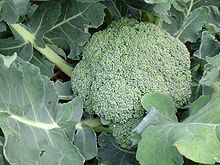Goitrogen

Goitrogens are substances that disrupt the production of thyroid hormones. This triggers the pituitary to release thyroid-stimulating hormone (TSH), which then promotes the growth of thyroid tissue, eventually leading to goiter.[1]
Goitrogenic drugs and chemicals
[edit]Chemicals that have been shown to have goitrogenic effects include:
- Sulfadimethoxine (Albon),[2] propylthiouracil,[3] potassium perchlorate,[4] and iopanoic acid.[5]
- Some oxazolidines such as goitrin.[6]
- Ions such as thiocyanate[7] (from cigarette smoking for example[8]) and perchlorate decrease iodide uptake by competitive inhibition and, as a consequence of reduced thyroxine and triiodothyronine secretion by the gland, cause, at low doses, an increased release of thyrotropin (by reduced negative feedback), which then stimulates the gland.[citation needed]
- Amiodarone inhibits peripheral conversion of thyroxine to triiodothyronine; also interferes with thyroid hormone action.[citation needed]
- Lithium inhibits thyroid hormone release.[citation needed]
- Phenobarbitone, phenytoin, carbamazepine, rifampin induce metabolic degradation of triiodothyronine (T3) and thyroxine (T4).[citation needed]
Goitrogenic foods
[edit]Foods which have been demonstrated to have goitrogenic effects include soy, cassava (when crushed and not detoxified by soaking,[7]) vegetables in the genus Brassica (such as broccoli and cabbage),[9][page needed] and other cruciferous vegetables.[10] In places where iodine deficiency exists in tandem with millet being a major component of the diet, millet consumption can contribute to thyroid enlargement which is the start of endemic goiter.[11]
See also
[edit]References
[edit]- ^ Bender, David A. (2009). "Goitrogens". A dictionary of food and nutrition (3rd ed.). Oxford: Oxford University Press. ISBN 9780199234875.
- ^ Blackwell T, Werdin R, Eisenmenger M, FitzSimmons M (March 1989). "Goitrogenic effects in offspring of swine fed sulfadimethoxine and ormetoprim in late gestation". Journal of the American Veterinary Medical Association. 194 (4): 519–523.
- ^ Rosenfeld H, Ornoy A, Shechtman S, Diav-Citrin O (2009). "Pregnancy outcome, thyroid dysfunction and fetal goitre after in utero exposure to propylthiouracil: a controlled cohort study". Br J Clin Pharmacol. 68 (4): 609–17. doi:10.1111/j.1365-2125.2009.03495.x. PMC 2780286. PMID 19843064.
- ^ Soldin OP, Braverman LE, Lamm SH (2001). "Perchlorate Clinical Pharmacology and Human Health: A Review". Ther Drug Monit. 23 (4): 316–31. doi:10.1097/00007691-200108000-00002. PMC 3640367. PMID 11477312.
- ^ Andreucci M, Solomon R, Tasanarong A (2014). "Side Effects of Radiographic Contrast Media: Pathogenesis, Risk Factors, and Prevention". Biomed Res Int. 2014: 741018. doi:10.1155/2014/741018. PMC 4034507. PMID 24895606.
- ^ Verhoeven DT, Verhagen H, Goldbohm RA, van den Brandt PA, van Poppel G (February 1997). "A review of mechanisms underlying anticarcinogenicity by brassica vegetables". Chem. Biol. Interact. 103 (2): 79–129. doi:10.1016/S0009-2797(96)03745-3. PMID 9055870.
- ^ a b Vanderpas J (2006). "Nutritional epidemiology and thyroid hormone metabolism". Annu. Rev. Nutr. 26: 293–322. doi:10.1146/annurev.nutr.26.010506.103810. PMID 16704348.
- ^ Erdogan MF (2003). "Thiocyanate overload and thyroid disease". BioFactors (Review). 19 (3–4): 107–11. doi:10.1002/biof.5520190302. PMID 14757960.
- ^ Mitchell, Richard Sheppard; Kumar, Vinay; Abbas, Abul K.; Fausto, Nelson (2007). Robbins Basic Pathology (8th ed.). Philadelphia: Saunders. ISBN 978-1-4160-2973-1.
- ^ Gaitan, Eduardo (July 1990). "Goitrogens in Food and Water". Annual Review of Nutrition. 10 (1): 21–37. doi:10.1146/annurev.nu.10.070190.000321. PMID 1696490.
- ^ Eduardo Gaitan; Raymond, H. Lindsay; Robert D. Reichert; Sidney H. Ingbar; Robert C. Cooksey; Jim Legan; Edward F. Meydrech; John Hill; Ken Kubota (1989). "Antithyroid and Goitrogenic Effects of Millet: Role of C-Glycosylflavones". The Journal of Clinical Endocrinology & Metabolism. 68 (4): 707–714. doi:10.1210/jcem-68-4-707. PMID 2921306.


 French
French Deutsch
Deutsch